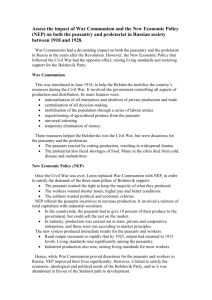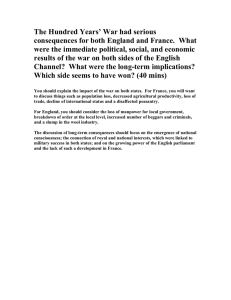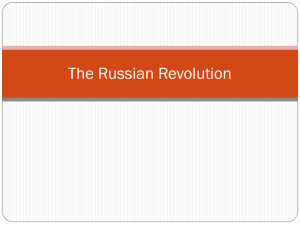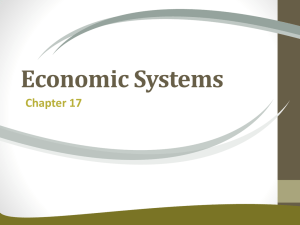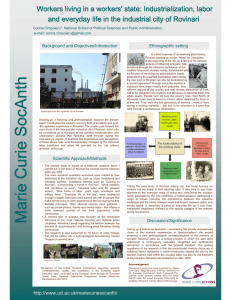Christopher Wutzke
advertisement
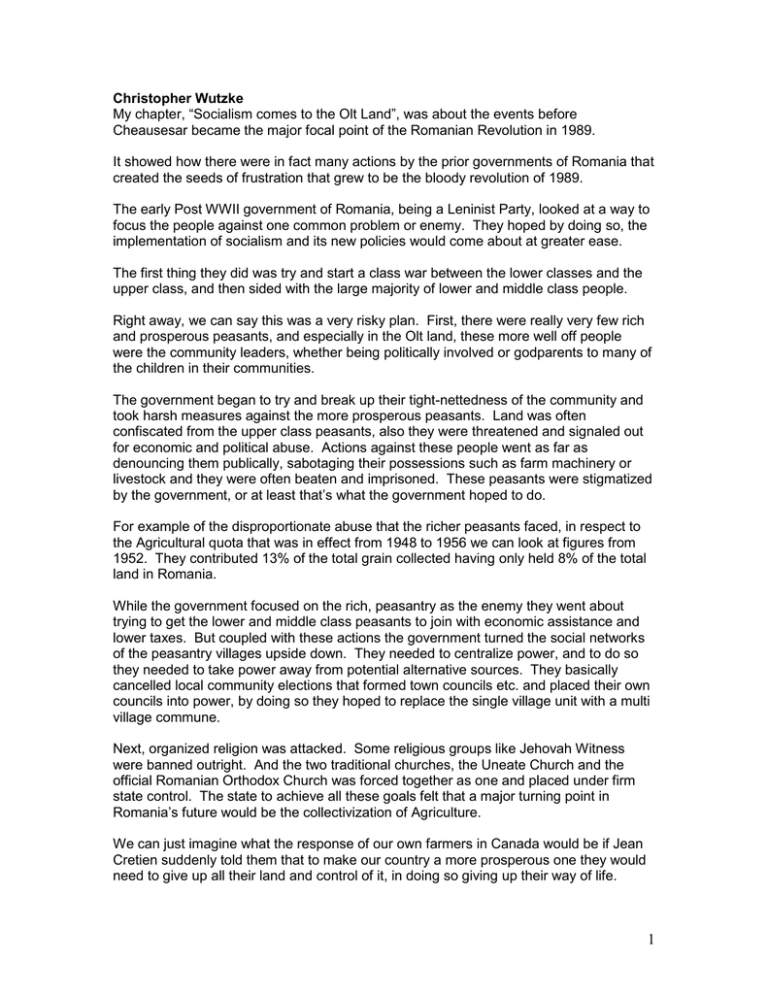
Christopher Wutzke My chapter, “Socialism comes to the Olt Land”, was about the events before Cheausesar became the major focal point of the Romanian Revolution in 1989. It showed how there were in fact many actions by the prior governments of Romania that created the seeds of frustration that grew to be the bloody revolution of 1989. The early Post WWII government of Romania, being a Leninist Party, looked at a way to focus the people against one common problem or enemy. They hoped by doing so, the implementation of socialism and its new policies would come about at greater ease. The first thing they did was try and start a class war between the lower classes and the upper class, and then sided with the large majority of lower and middle class people. Right away, we can say this was a very risky plan. First, there were really very few rich and prosperous peasants, and especially in the Olt land, these more well off people were the community leaders, whether being politically involved or godparents to many of the children in their communities. The government began to try and break up their tight-nettedness of the community and took harsh measures against the more prosperous peasants. Land was often confiscated from the upper class peasants, also they were threatened and signaled out for economic and political abuse. Actions against these people went as far as denouncing them publically, sabotaging their possessions such as farm machinery or livestock and they were often beaten and imprisoned. These peasants were stigmatized by the government, or at least that’s what the government hoped to do. For example of the disproportionate abuse that the richer peasants faced, in respect to the Agricultural quota that was in effect from 1948 to 1956 we can look at figures from 1952. They contributed 13% of the total grain collected having only held 8% of the total land in Romania. While the government focused on the rich, peasantry as the enemy they went about trying to get the lower and middle class peasants to join with economic assistance and lower taxes. But coupled with these actions the government turned the social networks of the peasantry villages upside down. They needed to centralize power, and to do so they needed to take power away from potential alternative sources. They basically cancelled local community elections that formed town councils etc. and placed their own councils into power, by doing so they hoped to replace the single village unit with a multi village commune. Next, organized religion was attacked. Some religious groups like Jehovah Witness were banned outright. And the two traditional churches, the Uneate Church and the official Romanian Orthodox Church was forced together as one and placed under firm state control. The state to achieve all these goals felt that a major turning point in Romania’s future would be the collectivization of Agriculture. We can just imagine what the response of our own farmers in Canada would be if Jean Cretien suddenly told them that to make our country a more prosperous one they would need to give up all their land and control of it, in doing so giving up their way of life. 1 The people of Romania’s way of life began to change. Government officials in March of 1949 were sent to the countryside to “explain” the benefits of the new Agricultural organizations that the government hoped to form. By doing so, 1000 farms with some 70,000 households were established by the end of 1950. But the people realized what was happening to them and how their lives would change and resistance stiffened. The following year a meager 62 farms were formed compared to the following years 1000. The party blamed the government officials for the lower numbers in the following year and said they didn’t need to “explain” it quite so well or people would become very reluctant to join without being outright forced to. They also blamed the backward “family oriented” peasants for not putting country before family. To counter these problems the government in a sense lightened up a bit. They established a new transitional organization - the intovarasine agricol or agricultural association in September of 1952. The associations were a mixture of private and socialist relationships. The members could contribute as much or as little land as they desired whereas the collective farmers were expected to contribute all their land except their houses and outlying buildings. The association land was private but were amalgamated to allow joint labour, whereas collective lands were joint property. The members of the association, were paid by the amount of land they contributed but the collective members were only paid by the amount of labour they contributed. And the associations still promoted collectivization by giving peasants year round access to state owned machinery which few could get access to otherwise. The associations grew rapidly through the 1950s. In 1952 to 1958 their numbers increased from 1800 to over 12,000 and had more than a million members. However, they were doomed from the start. The associations contradicted socialism doctrine. They didn’t centralize production, they allowed individuals to have their own property, and the members were paid by how much land was contributed by them. Full collectivization was announced in 1961 when 80% of Romanian land was in the socialist sector. The Romanian government hoped to turn a rural population into a capable industrial work force and to relocate social life from the rural community to the industrial workplace. Educational expansion went along with the industrial and social policy. Between 1938 and 1960 school attendance increased by 300%. But the major focus of the educational reform over all others were ideological. The “individual interests” were to be replaced with the interests of the state; the ultimate objective being the creation of a “new socialist man”. Through all of this, the Olt landers suffered. The unreproductiveness of their farms, its socioeconomic structure and the intensive industrialization process that threatened the way they lived made them very prejudice against socialism. The agriculture quotas imposed on the Olt landers were unrealistic and drove them into extreme deprivation. The quotas were so high that some had to go and buy more product to reach the limits expected to be turned in set by the government. As we saw 2 in “Russian Talk” the suffering was fairly equal among the people and in a sense brought them closer together unifying them. But the suffering was not equal. With the mixture of systems, the bribery of officials and though it wasn’t supposed to exist, the social economic class system, all lent a hand in making the suffering unequal. The peasantry were classified by economic status and this decided the level of the quota the household would have to meet. But the classification system left much to be desired as personal relationships with officials or bribery could influence the level quota put on a household. Other peasantry were able to manipulate the system by spreading their wealth through their families. And it was also known that officials ??? actual quotas of upper class classifications they needed to fulfill per village. So very often people were far from upper class had to somehow fulfill an upper class quota. This of course caused the peasantry to be less social to one another. The peasantry reverted more so into the family and 3 generation families living under one roof were becoming the norm, something the government was very much against. Yet even with the industrial growth in Romania farm labor was still needed. Some people who actually wanted to leave the farm were refused permission to work in industry. Romanian had in a sense come full circle. They made it so difficult to survive in Agriculture that the Romanian peasantry’s youth choose education and would not accept the land given to them through inheritance, instead giving it to a younger sibling. This movement forced the government to control the people even more so. As they used refusal industry as a method to ensure they would have some agricultural production. The implementation of the socialist power generated a mass social transformation that had far reaching consequences. There were some benefits to the socialist policies that were implemented such as higher economic choice, modernized villages, better education and an overall more modern people. But the attack on upper class peasantry weakened the socialist ties with local governments. And homogenized the conditions of most peoples lives of one of shared suffering. The people were left with few alternatives but to act in a passive aggressive manner towards the socialist government. 3 by Hülya Demirdirek University of Oslo Department of Anthropology 14 December 2001 4
